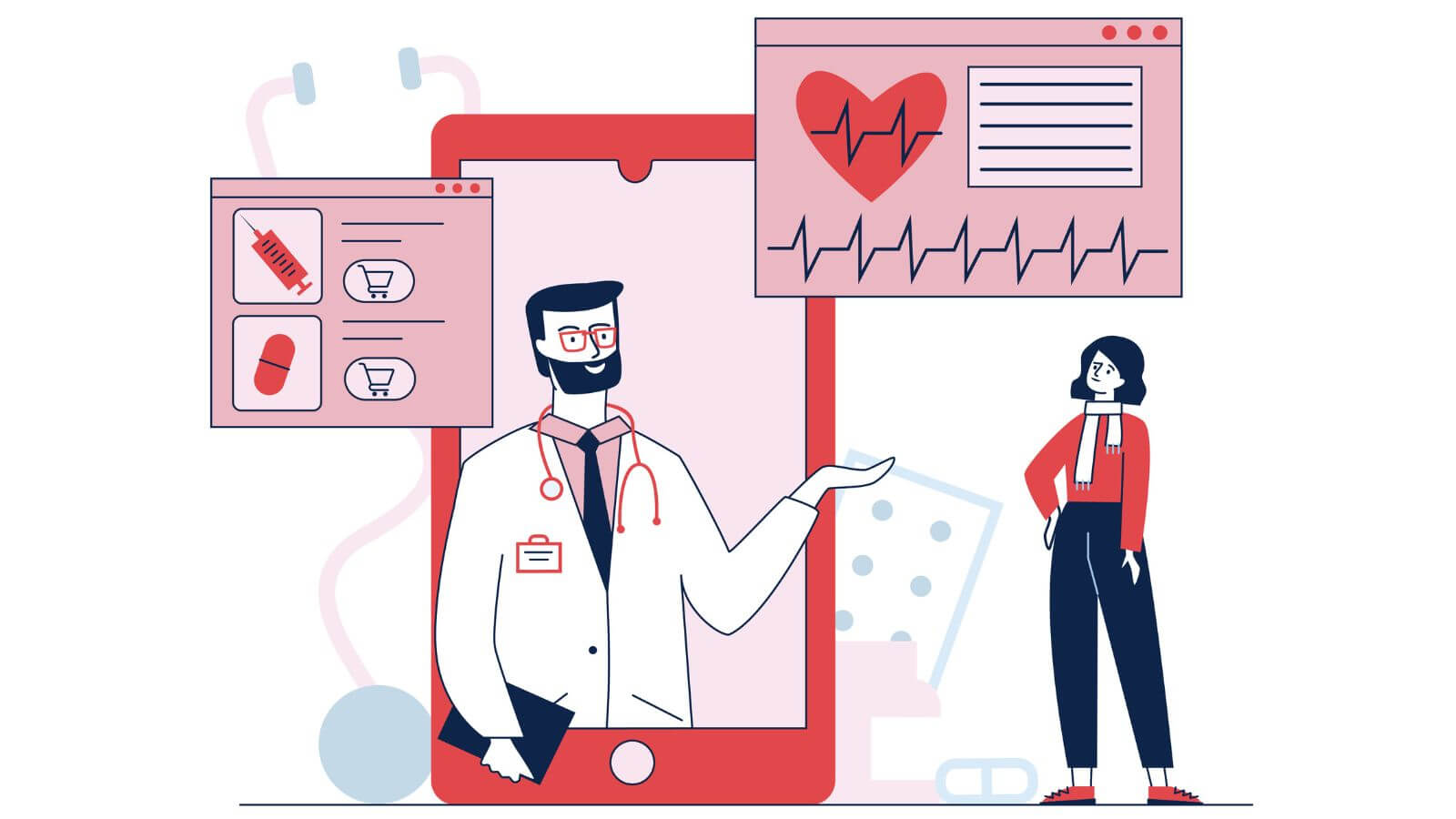How Much Does It Really Cost to Develop a Healthcare App?
Introduction Healthcare apps have revolutionized the way we access medical information, connect with healthcare professionals, and manage our well-being. Healthcare apps provide a variety of features like appointment scheduling, medication reminders, fitness tracking, and telemedicine consultations to improve healthcare experiences. However, developing such applications can be costly due to various factors. In this blog post, we will explore the key factors that affect the cost of developing a healthcare/ medical app and provide you with a comprehensive understanding of the financial implications involved. The cost of developing a healthcare/ telemedicine/ medical app is influenced by several factors, including complexity and functionality, design and user experience, and platform and device compatibility. Some common features include: The complexity of implementing these features and their integration with existing systems or databases can impact the development cost. Apart from the core features, healthcare apps may require additional functionalities tailored to specific use cases. These may include: Many healthcare apps rely on third-party integrations to enhance their capabilities. These integrations may involve: Each third-party integration requires additional development effort and may increase cost of the app.Factors Affecting the Cost of Healthcare App Development
Complexity and Functionality
1) Core features and functionalities:
2) Integration of additional features:
3) Third-party integrations:
Share your project details to build your path toward success.
Design and User Experience
A well-designed user interface (UI) and a seamless user experience (UX) are crucial for the success of a healthcare app. The design and UX elements can influence the cost of development.
(1) UI/UX design considerations:
Creating an intuitive and visually appealing UI/UX design requires expertise and careful consideration. Factors that impact the cost include:
- Wireframing and prototyping
- Graphic design and visual elements
- Iconography and typography
- Colour schemes and branding
- User flow and navigation structure
The more intricate and customised the UI/UX design, the higher the development cost.
(2) Customization and Branding:
Some healthcare apps may require customization to match a specific healthcare provider's branding or target audience preferences. This involves tailoring the app's color scheme, logo, and other visual elements. Customization adds an extra layer of complexity, potentially affecting the development cost.
Platform and Device Compatibility
The choice of platforms and devices for app development is another significant factor affecting the cost.
1. iOS vs. Android development:
Developing an app for both iOS and Android platforms increases the development scope and cost. Each platform has its own design guidelines and technical requirements, making it necessary to develop separate codebases. However, targeting both platforms can expand the app's user base and potential reach.
2. Responsive design and optimization:
Healthcare apps need to be compatible with different devices, including smartphones, tablets, and wearable devices. Implementing responsive design principles ensures a consistent user experience across various screen sizes and resolutions.
Development Team and Resources
The choice between building an in-house development team or outsourcing the development process can significantly affect the cost of developing a healthcare app.
(1) In-house development team
Building an in-house team offers advantages in terms of control and collaboration but involves additional costs.
Roles and Responsibilities:
An in-house development team typically consists of various roles, including:
- Project manager
- UI/UX designer
- Front-end developer
- Back-end developer
- Quality assurance specialist
- Database administrator
Each role contributes to the app development process, and the associated costs include salaries, benefits, and training expenses.
Hiring and Onboarding Costs:
Building an in-house team often requires recruiting new members or expanding an existing team. The costs associated with hiring and onboarding include:
- Job advertisements and recruitment agencies
- Interviewing and screening candidates
- Onboarding and training programs
These costs should be considered when estimating the overall cost of developing a healthcare app in-house.
(2) Outsourcing Development
Outsourcing offers several advantages, including:
- Cost savings through lower labor costs
- Access to specialized expertise
- Faster time to market
- Scalability and flexibility
However, there are also potential drawbacks, such as language and cultural barriers, differences in time zones, and challenges in ensuring effective communication and collaboration.
Choosing The Right Healthcare App Development Partner
When outsourcing app development, it is crucial to select the right development partner. Considerations for choosing a reliable and competent partner include:
- Relevant industry experience
- Portfolio and client references
- Technical expertise and capabilities
- Communication and project management processes
A thorough evaluation will help ensure a successful collaboration and the desired quality of the healthcare app.
Development Process and Timeline
The development process and timeline can vary based on the complexity of the app and the chosen development approach.
(1) Discovery and Planning Phase
The initial phase involves understanding project requirements and planning the app's development.
Defining project requirements:
During this phase, project requirements are documented, including:
- Functional requirements
- Technical requirements
- UI/UX design specifications
- Integration requirements
Defining these requirements in detail helps provide a clear roadmap for the development process.
Wireframing and Prototyping:
Wireframing and prototyping are essential steps in visualising the app's structure and user flow. These interactive mockups help stakeholders and developers gain a shared understanding of the app's functionality before proceeding to development.
(2) Development Phase
The development phase involves the actual coding and implementation of the app.
Front-end and Back-end Development:
Front-end development focuses on the user-facing elements of the app, including UI components and user interactions. Back-end development involves building the server-side infrastructure, database management, and implementing business logic.
Quality Assurance and Testing:
Thorough testing is crucial to ensure the app's functionality, stability, and security. Quality assurance (QA) specialists conduct various types of testing, including:
- Functional testing
- Performance testing
- Security testing
- Compatibility testing
Bugs and issues discovered during testing are addressed and resolved before moving to the next phase.
Deployment and Ongoing Maintenance
After the completion of development and testing, the app is ready for deployment.
1. App Store Submission:
The submission process includes complying with the app store guidelines, preparing app descriptions, and uploading the necessary assets.
2. Bug Fixes and Updates:
After the initial deployment, ongoing maintenance and updates are necessary to address bug fixes, performance enhancements, and feature updates.
Cost Breakdown
Estimating the precise expense associated with the development of a healthcare app can pose a challenge given the multitude of factors and variables involved.
Development Cost Estimation
The development cost can be estimated using different pricing models, including time-based models and fixed-price contracts.
1) Time-based Pricing Models:
Time-based models involve charging based on the number of hours spent on development. Common pricing structures include:
- Hourly rates: Developers are paid an hourly rate for their work.
- Weekly or monthly rates: A fixed rate is agreed upon for a specific period.
- Dedicated team: A team is assigned exclusively to the project for a fixed duration, and costs are determined based on the team's size and expertise.
2) Fixed-price Contracts:
In fixed-price contracts, the development cost is agreed upon in advance, considering the project requirements and deliverables.
3) Other Cost Considerations
App Hosting and Infrastructure:
Hosting the app on servers and ensuring its scalability and performance may incur additional costs. Factors to consider include:
- Cloud hosting services
- Data storage and backup solutions
- Content delivery networks (CDNs) for optimized content delivery
Post-launch Marketing and Support:
Promoting the app and ensuring user engagement may require a marketing and support budget. Examples of post-launch activities include:
- App store optimization (ASO) for improved visibility
- Digital marketing campaigns
- Customer support and user feedback management
Real-Life Examples
To provide more context, here are a few real-life examples of healthcare app development costs:
Example 1: Development Cost of a Telemedicine App
A telemedicine app allows patients to consult with healthcare professionals remotely. The cost estimation for such an app could include:
- Core features and functionalities: user registration, video consultations, prescription management, and appointment scheduling.
- Additional features: integration with electronic health records (EHR), payment gateway, and lab test results integration.
- UI/UX design: custom design with branding elements.
- Platform compatibility: iOS and Android development.
- Development team: a project manager, UI/UX designer, front-end and back-end developers, QA specialist.
- Development timeline: estimated at 3 to 6 months.
The total cost of developing a telemedicine app can range from $60,000 to $130,000, depending on the complexity and specific requirements.
Example 2: Development Cost of a Patient Management App
A patient management app helps healthcare providers streamline their administrative tasks and patient records. The cost estimation for such an app could include:
- Core features and functionalities: patient registration, appointment scheduling, medical history management, and notifications.
- Additional features: integration with electronic health records (EHR), insurance verification, and billing.
- UI/UX design: custom design with emphasis on user-friendly interface and navigation.
- Platform compatibility: iOS and Android development.
- Development team: a project manager, UI/UX designer, front-end and back-end developers, QA specialist.
- Development timeline: estimated at 6 to 9 months.
The total cost of developing a patient management app can range from $80,000 to $180,000, depending on the complexity and specific requirements.
Example 3: Development Cost of a Medication Reminder App
A medication reminder app helps users manage their medications and receive timely reminders. The cost estimation for such an app could include:
- Core features and functionalities: medication reminders, pill tracking, dosage instructions, and medication history.
- Additional features: integration with pharmacy systems for prescription refills, medication database, and drug interaction checker.
- UI/UX design: clean and intuitive design with emphasis on ease of use.
- Platform compatibility: iOS and Android development.
- Development team: a project manager, UI/UX designer, front-end and back-end developers, QA specialist.
- Development timeline: estimated at 3 to 6 months.
The total cost of developing a medication reminder app can range from $40,000 to $1,00,000, depending on the complexity and specific requirements.
Conclusion:
The development of a healthcare mobile app encompasses various factors that directly affect the total cost. It is essential to carefully evaluate these above key factors and consider the long-term benefits and potential return on investment when estimating the cost of developing a healthcare app.
Are you searching for affordable healthcare mobile applications? We are here to help!
Please don't hesitate to contact us. you can reach out to us to learn more about our high-quality healthcare mobile app development services by emailing us at sales@iihglobal.com. We're excited to assist you!







